Bloom Bloom Pow: Finishing the top
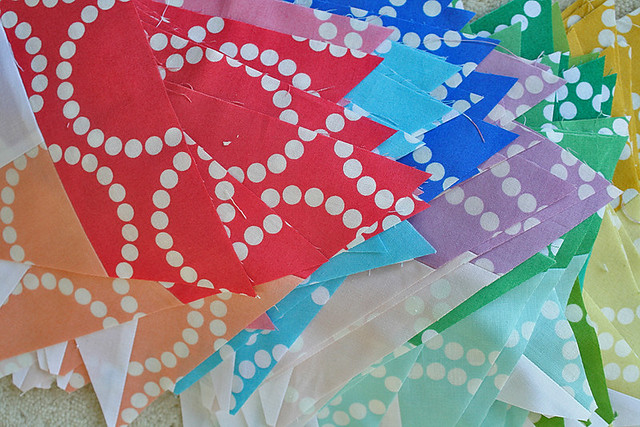
Welcome back to the Bloom Bloom Pow Quilt-Along! Today's an exciting day, because we're going to take all those triangles we cut last time and sew them together into a finished quilt top! You'll finally get to see some results after all this work, which is always a good moment.
The very first thing we're going to do is sew like-colored triangles together into groups of three. We're going to do this before we worry about our layout, which is unusual, of course. But like colors will be together in the final quilt layout anyway, so by piecing them into groups of three first, we'll have fewer pieces to worry about when we put the quilt up on the design board (or down on the design floor, in my case).
Piecing equilateral triangles really isn't hard once you get the hang of it, and if you know a few tricks, which I'm about to share with you today. So grab a group of three same-colored triangles and let's jump right in.
Piecing the half-hexagons:
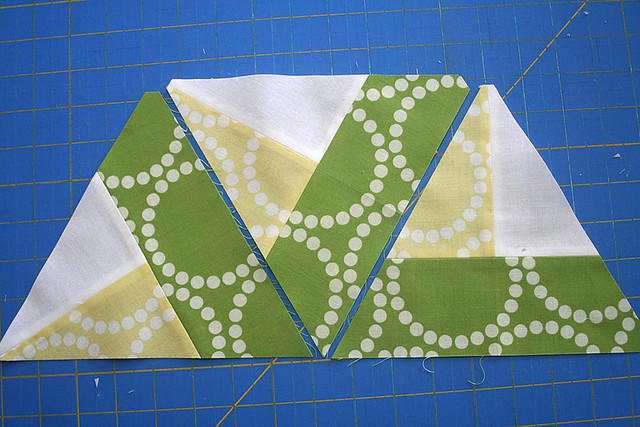
1. Arrange the three triangles so that the darker "petals" radiate out like spokes, as shown.
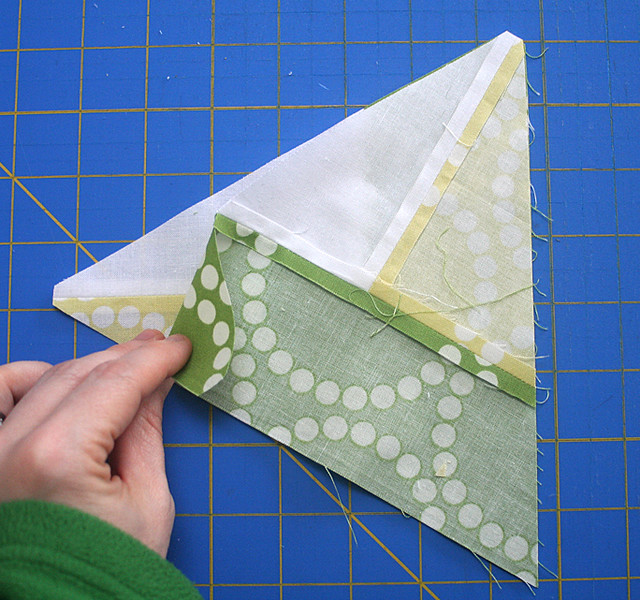
2. Working from left to right, pair up the triangle on the far left with the middle triangle, right sides together, as shown. Just line up these first two triangles neatly, corners matched.

Any time you're matching up a pointed corner with a notched corner, it should look like the picture above. The sides of the pieces should still line up—the pointed corner should just look like a continuation of the notched corner.
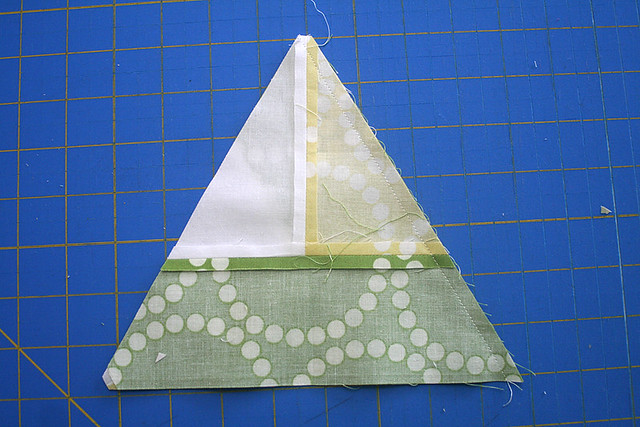
3. Sew a 1/4" seam along the right-hand side of the matched-up triangles, as shown.

4. Press seam allowances open. Now it should look like this. You've sewn your first two triangles together!
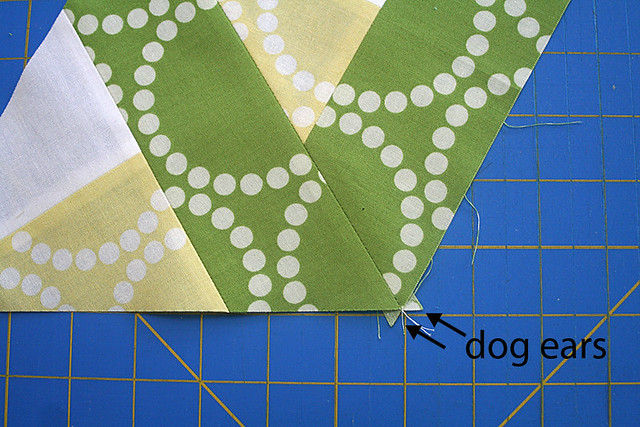
Hey, see these little triangles that are sticking out, now that you've sewn the first seam? They're called dog ears. Don't trim them off! I know it's tempting, but you're going to use them as a guide when you add the next triangle.
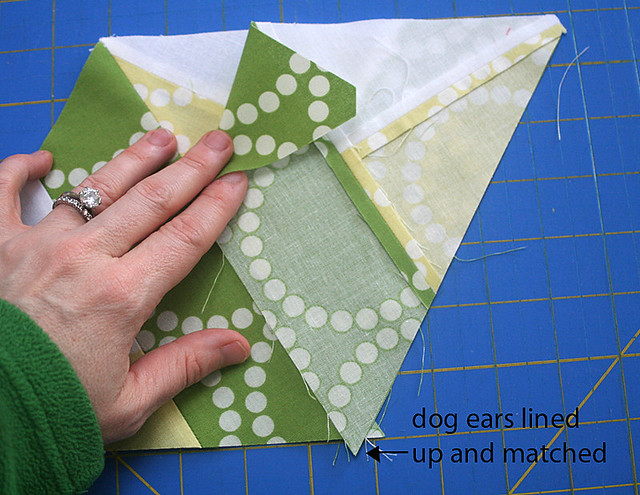
5. Next, add the third triangle by laying it on top of the middle triangle, right sides together, as shown. You're going to line up the bottom corner of this triangle with that lower dog ear.

6. Sew a 1/4" seam along that right-hand side, just like we did for the first seam. If everything was cut and aligned correctly, your 1/4" seam should go right through the intersection where the dog ear meets the straight edge of the first triangle, as shown above. See that? If your seam hits right at that sweet spot, your triangles will line up perfectly. (If your seam didn't quite make it to that spot, no worries. This is actually a pretty forgiving block, since there are so few seams that actually need to line up. Close enough is good enough!)
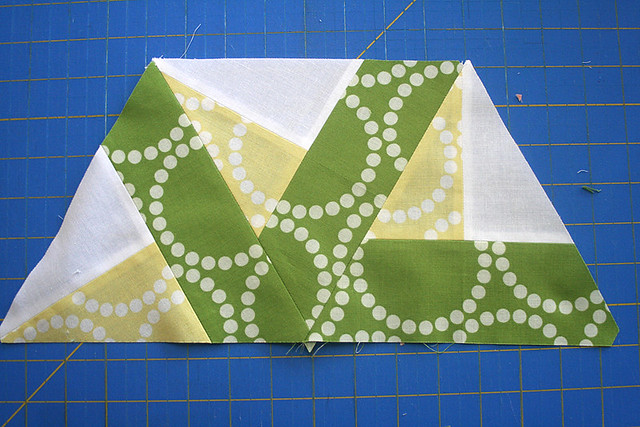
7. You should now have a half-hexagon that looks very much like this.
These half-hexagons will be sewn together in straight horizontal rows to make up the quilt top.
So whatever you do, do not piece these triangles together into full hexagon groups of 6! You'll make things a whole lot harder on yourself if you do—half-hexagons allow you to piece the top together in rows, while making full hexagons would require Y seams. Nobody wants that. LOL.
8. So just keep sewing those triangles together into groups of three until all the triangles have been turned into half-hexagons. Once you've done that, it's time to actually lay out your quilt top!
Piecing the rows:
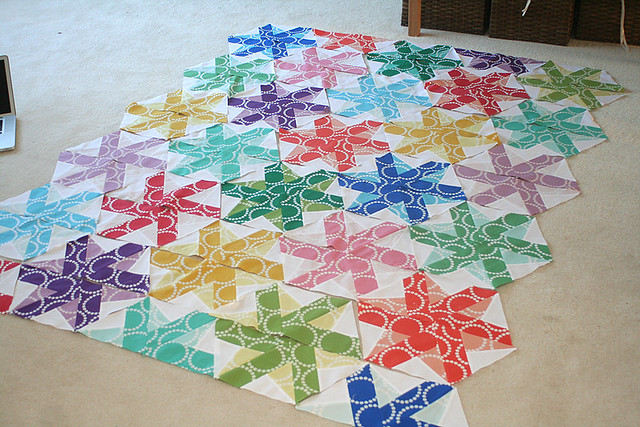
This is the fun part! You're going to take all those half-hexagons and come up with a final layout. This part is really up to you—if you're using Pearl Bracelets, you can follow my color scheme above, or you can do your own thing. It's up to you!
Whatever you do, here are a few guidelines for deciding on a layout:- There's no wrong answer! Much like the light and dark value/color pairings that you decided on earlier in the quilt-along, this part of the quilt-along is entirely personal preference. The ideal layout is the one that you like. : )- I tried to distribute light/dark values and warm/cool colors as evenly as possible across the quilt. I also tried to keep like colors from touching each other. That's not always possible, but I tried my best!- Take a picture and convert it to black and white to check value placement—much like we did in the design strategy post when we were deciding on our light/dark value pairings. Darker and lighter blocks should be scattered evenly across the quilt top.
1. Once you're satisfied with your layout, it's time to sew the top together! (You might want to snap a picture of your layout before you start, just in case the layout gets mixed up, your dog walks across it, etc.) You're going to work your way across the quilt, piecing straight horizontal rows.

2. To piece two half-hexagons together horizontally, it works very much the same way as piecing the triangles did earlier. Grab your first two half-hexies from the top row.

3. Lay them out, right sides together, along the seam to be sewn, as shown. Again, align the corners of the triangles and sew a 1/4" seam along the raw edges (where the pins are in the photo above).
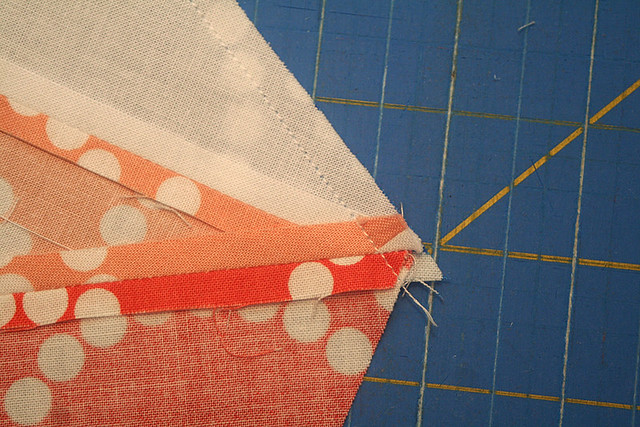
Again, your seam should hit right where the straight triangle edge meets the dog ear. Sometimes, if you're dealing with a notched triangle edge (as is the case in the photo above), there won't be two dog ears to line up, but it still should be fairly obvious where the dog ear would have been if it weren't for that notch. That spot is where the seam should go through.
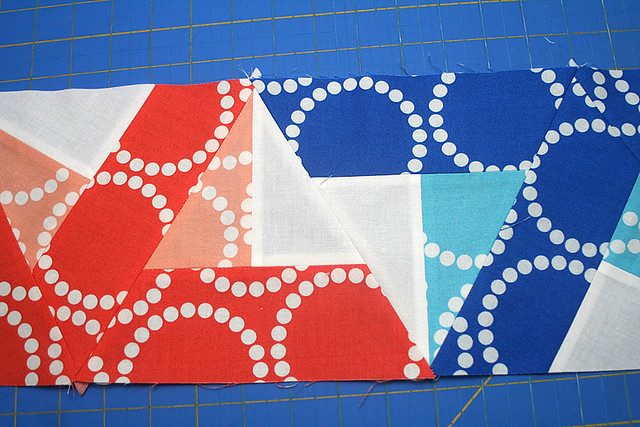
4. The pair of pieced half-hexagons should look something like this when you're done. Keep on piecing those half-hexagons together to create the horizontal rows.
Putting the rows together
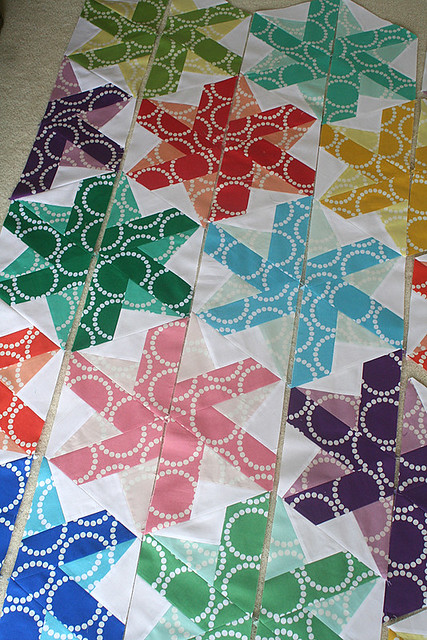
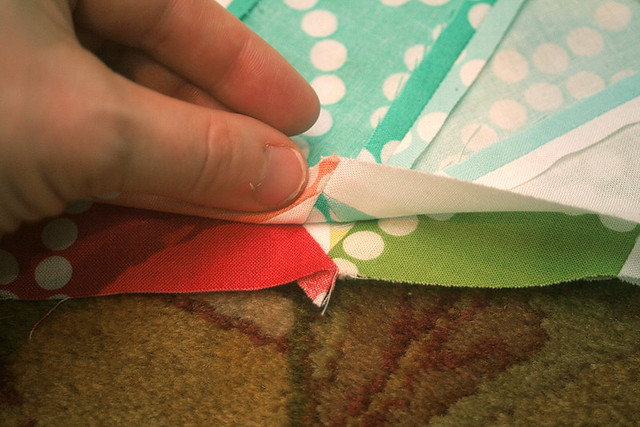
Now that your rows are pieced, all you have to do is put the horizontal rows together to create the top.
1. Put two rows together, raw edges aligned, right sides together. When the two rows are neatly lined up, I pull back the top layer just a bit at each place where seams come together in a point, as shown above. I do this to make sure points are matched up, as shown above. Ideally, you want your points to touch, and when you sew the seam, your seam should go right through the point. Pin right through the points when everything is lined up the way you want it.
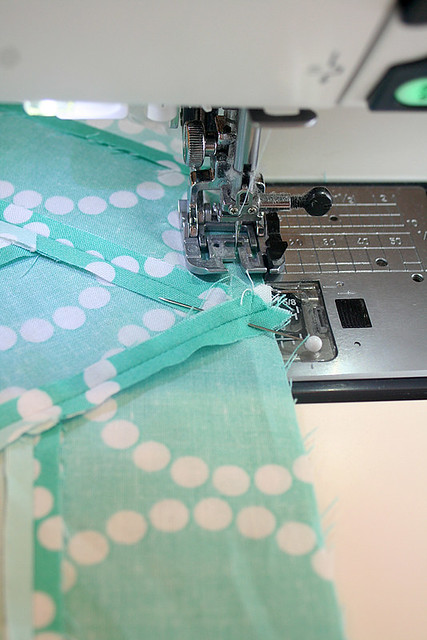
2. I highly recommend using a walking foot or dual-feed foot to sew your rows together. There are two reasons for this. One is that you'll find there is a lot of seam bulk in certain spots along the rows, so a walking foot or dual-feed foot will help you get over that bulk. The other reason is that a walking foot doesn't push the fabric as you sew, which makes it easier to force seams to line up in certain places along a long seam like this. I have the quarter-inch dual-feed foot for my Janome 7700 and use it for piecing in situations like this all the time. Another hint is to leave the pins in place as you are sewing, taking them out at the last minute (or don't take them out at all—I sew right over pins and have never had a problem with it). And that's it! Keep sewing those rows together until you have a completed top.
Next week, I'll show you how to trim the top so that it has straight edges, and we'll talk about different quilting, finishing, and binding options. And that's it for this QA! I can hardly believe we're already almost done already! It's been so much fun quilting along with you lovely people, and I can't wait to see all of your finished creations. In fact, I'm planning to feature some of your projects here on my blog—I may run photos of finished tops and quilts, or I'll host a linky so that people can show off their work and check out others'. I haven't decided exactly how to do it just yet, so if you have any thoughts, please share! In the meantime, enjoy piecing your triangles, and I can't wait to see you all back here next week for the final QA post! : )
Quilt-Along Schedule
March 21
-
Introduction and fabric requirements
March 28
-
(we'll just be talking about the big picture here, so you won't need your fabric yet for this post)
April 4
-
April 11
-
April 18
-
Cutting the triangles and deciding on a layout
April 25
-
Piecing the triangles to complete the top
May 2
-
